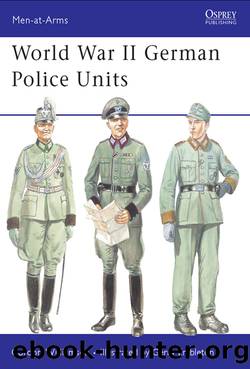World War II German Police Units by Gordon Williamson

Author:Gordon Williamson
Language: eng
Format: epub
Tags: World War II German Police Units
ISBN: 9781780963402
Publisher: Osprey Publishing
Published: 2011-12-13T16:00:00+00:00
Feuerwehren
Although this branch should really be considered an auxiliary force, it is dealt with here for the sake of simplicity. As already noted, the Feuerwehr consisted of those part-time volunteer firemen who served rural communities, but also included some other, smaller organizations:
Freiwillige Feuerwehr The local part-time volunteer fire brigades in rural communities; after the creation of the Feuerschutzpolizei, these were officially classed as Technische Hilfspolizei (Technical Auxiliary Police). Each village or district was obliged by law to create such a fire service. Although civilian volunteers, the members came under the direct control of the Ordnungspolizei.
Pflichtfeuerwehr With wartime demands on manpower, there were often occasions when there were insufficient volunteers to create a fire brigade. In such cases the authorities were entitled to draft suitable individuals for compulsory service. All German males between 17 and 65 were liable for call-up to serve in the Feuerwehr.
Werkfeuerwehren These were organized by the management of individual factories and manned by employees of the firm. The decision as to whether a Werkfeuerwehr was to be created was a matter for higher authorities. Minimum manpower requirement for a Werkfeuerwehr was 18 men and one power-driven pump unit.
HJ-Feuerwehrscharen The Hitler Jugend also contributed volunteer auxiliary firemen. Each HJ-Feuerwehrschar consisted of around 45 to 50 youths divided into three fire-fighting squads or Kameradschaften, trained and equipped by the local Feuerwehr and at the disposal of the local fire chief.
The costs of all of these Feuerwehren were met by the local community. Feuerwehren within an area were under the control of a Bezirksführer appointed by the local Police President. His area of command would then be divided into several Kreise or districts each under a Kreisführer; subordinate to the Kreisführer might be several Unterkreisführer, with each individual Feuerwehr unit commanded by a Wehrführer. In the case of Pflichtfeuerwehren, such units came under the control of the nearest Feuerschutzpolizei commander.
The Feuerwehr wore the same dark blue uniform as the Feuer-schutzpolizei, but with their own collar patch and shoulder strap insignia.
Download
This site does not store any files on its server. We only index and link to content provided by other sites. Please contact the content providers to delete copyright contents if any and email us, we'll remove relevant links or contents immediately.
The Light of Days by Judy Batalion(834)
Stalin's War: A New History of World War II by Sean McMeekin(693)
The Pacific War 1941-1943 by James Holland(620)
Walk in My Combat Boots by James Patterson(617)
Victory's Price (Star Wars) by Alexander Freed(591)
The Vietnam War: An Intimate History by Geoffrey C. Ward & Ken Burns(575)
First Platoon: A Story of Modern War in the Age of Identity Dominance by Annie Jacobsen(569)
The American War in Afghanistan by Carter Malkasian(564)
Cold War (Alexander King Book 2) by Bradley Wright(560)
Operation Pedestal by Max Hastings(554)
Blood and Ruins: The Great Imperial War, 1931-1945 by Richard Overy(540)
The Madman Theory by Jim Sciutto(526)
Concepts of Space by Jammer Max;(524)
Extreme Fitness by Chris McNab(520)
Flying Tiger by Samson Jack(508)
World War II Infantry Fire Support Tactics by Gordon L. Rottman(507)
Pathfinders by AL-KHALILI JIM(499)
Panzerkrieg by Mike Syron(492)
Hitler’s Pre-Emptive War: The Battle for Norway, 1940 by Henrik O. Lunde(488)
